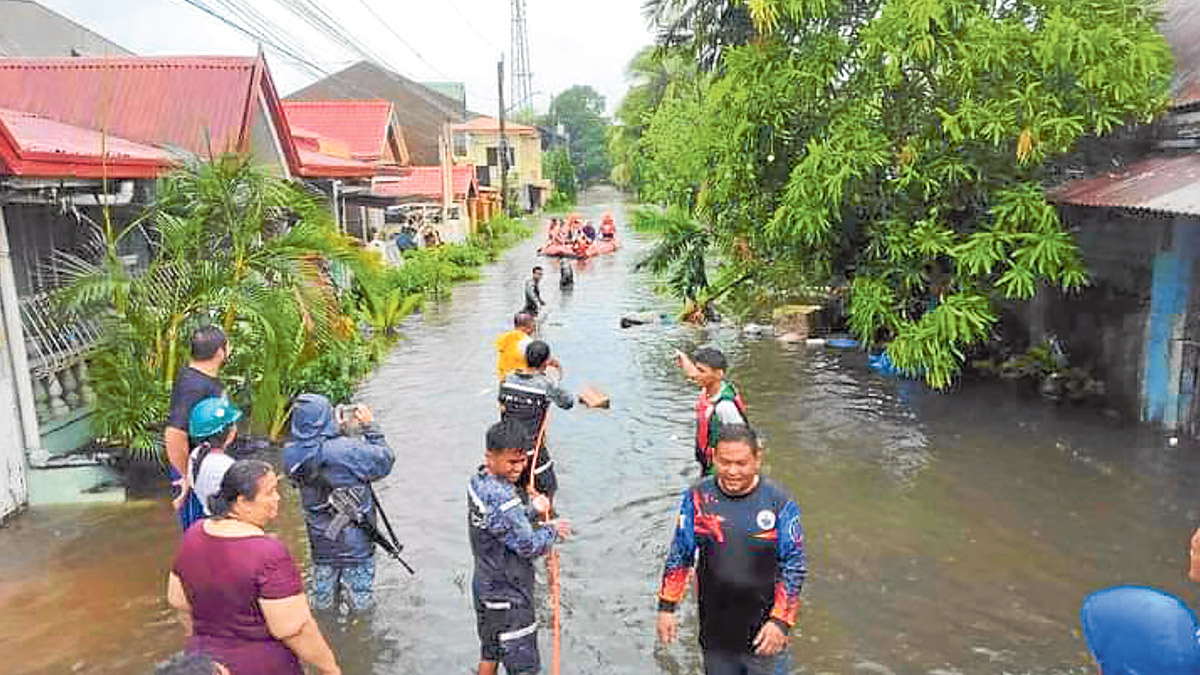
TO SAFETY Rescuers from the Quezon Provincial Disaster Risk Reduction and Management Office, along with members of the Philippine Air Force, arrive at Barangay Kanlurang Mayao in Lucena to help residents evacuate the flooded village on Sunday following the onslaught of Typhoon Aghon. —Photo courtesy of Quezon Provincial Government
MANILA, Philippines — The death toll from Typhoon Aghon (international name: Ewiniar) rose to seven as four more fatalities were reported by the police and local governments in Quezon and Misamis Oriental provinces on Tuesday. The national disaster response agency, however, has so far confirmed only one storm-related death pending verification of its field reports.
In his remarks before he left for a state visit to Brunei Darussalam on Tuesday, President Ferdinand Marcos Jr. said six regions were worst hit by the typhoon, which triggered floods and landslides, cut electricity supply and displaced thousands over the weekend.
The President segued from his departure speech to report the government’s response after Aghon battered provinces in southern Luzon and parts of Eastern Visayas.
READ: Pagasa lifts Signal No.1 as Typhoon Aghon moves away from PH
“At present, Regions 4 (Calabarzon and Mimaropa), 5 (Bicol), 6 (Western Visayas), 7 (Central Visayas) and 8 (Eastern Visayas) were hit, and 12,043 families, or 26,726 persons, were affected, while three airports and 29 seaports became non-operational due to the typhoon,” the President said.
A report from the National Disaster Risk Reduction and Management Council (NDRRMC) placed the number of displaced residents at 36,000. Meanwhile, the Department of Agriculture (DA) said that damage to agriculture was at P22.8 million as of Tuesday.
The DA added that the hardest-hit areas were Rizal, Cavite, Laguna, Quezon, Batangas and Marinduque provinces.
Marcos said he had directed the Department of Social Welfare and Development, the DA and the Department of Health to continue their relief efforts and assist all typhoon victims.
“We will continue to work and will not stop until we are able to help out all those affected, to all the victims affected by Aghon,” he said, noting that the Department of Public Works and Highways and the Department of Transportation would be involved in repairs of public infrastructures.
The President said the government had allotted P3 billion for relief efforts earlier.
More victims
In Quezon, reports from the provincial police said Germie Salibio, 56, caretaker of a cafe in Barangay Santol in Mauban town, was found dead on Monday morning. She drowned when the area was hit by floods at the height of Aghon’s onslaught on Sunday.
The police also reported two more fatalities in Lucena City—Melbert Señado, 39, who was hit by a falling tree in Barangay Ibabang Talim, and Archie Miguel, 22, who drowned in a river in the coastal village of Talao-Talao.
Authorities in Quezon reported earlier that a 7-month-old baby boy drowned in Padre Burgos town, while two others in Lucena City and San Antonio town died after falling trees hit them.
At least 1,250 families, or 5,607 people, had to flee their flooded villages in Lucena City. They stayed in schools, barangay halls, evacuation centers, and the Quezon Convention Center in Lucena, although most started returning home on Monday.
The NDRRMC confirmed the death of a 14-year-old girl in southern Misamis Oriental after a tree fell on a parked vehicle she was boarding.
State of calamity
On Monday, the provincial government of Quezon placed towns and cities under its first and second congressional districts under a state of calamity due to the extensive damage wrought by Aghon.
Declaring a state of calamity is crucial for local governments, as this would enable them to use their calamity funds for assistance.
The first district is composed of Tayabas City and the towns of Lucban, Pagbilao, Mauban, Sampaloc, Real, Infanta, General Nakar and the island municipalities of Polillo, Panukulan, Burdeos, Patnanungan and Jomalig. The second district is composed of the capital city of Lucena and the towns of Sariaya, Candelaria, Tiaong, Dolores and San Antonio.
The local government of Lucena had already placed the city under a state of calamity on Monday.
Aghon track
On Tuesday, Aghon was estimated at 535 kilometers east of Basco, Batanes province, packing maximum sustained winds of 130 kilometers per hour (kph) and gusts up to 160 kph. It was moving northeastward at 30 kph over the Philippine Sea, according to the 5 p.m. bulletin of the Philippine Atmospheric, Geophysical and Astronomical Services Administration (Pagasa).
No tropical cyclone wind signals were raised, but Pagasa said the southwest monsoon partially influenced by Aghon could still bring occasional gusty conditions to Batanes, Cagayan and Isabela provinces; the Ilocos, Central Luzon, Calabarzon, Mimaropa and Bicol regions, including Metro Manila; and Aklan and Antique provinces over the next 24 hours.